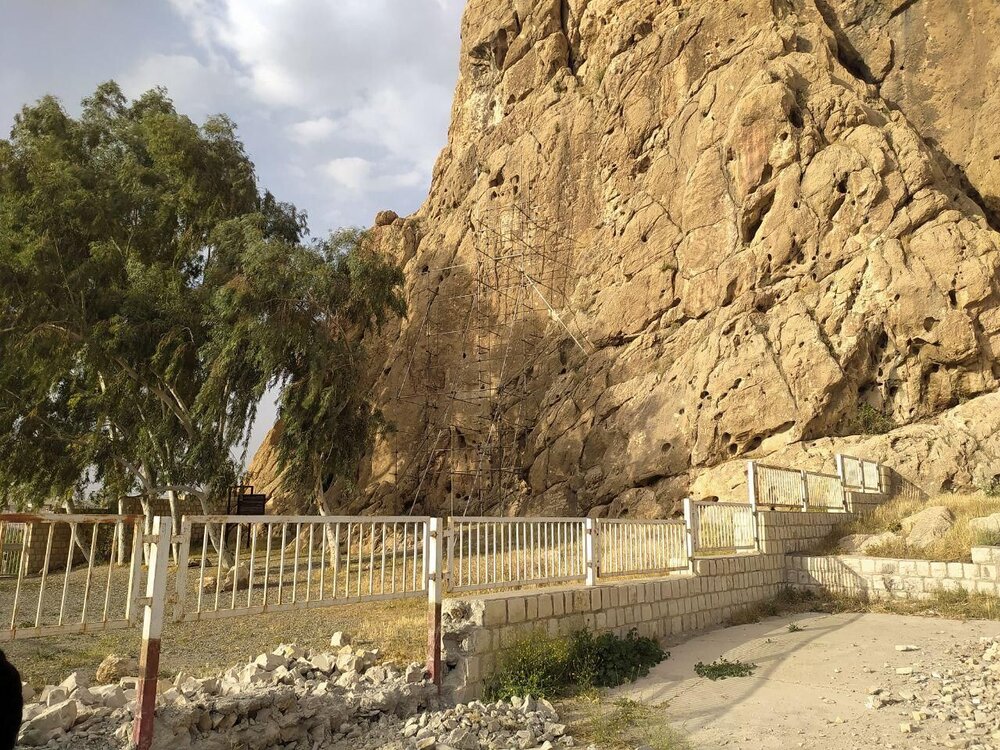Rock-hewn tomb, bas-relief carvings to undergo restoration in western Iran

TEHRAN – Restoration work is set to commence on a historical rock-hewn tomb and several associated bas-relief carvings, which are situated in Sarpol-e Zahab, western Iran.
“The millennia-old bas-reliefs of Anubanini and the rock-hewn tomb of Dokan-e-Davood are planned to undergo restoration work in near future,” IRNA quoted Sarpol-e Zahab’s governor as saying on Sunday.
Furthermore, local routes to the cited sites will be amended to promote both tourism and to help safeguard the cultural heritage of the region, the official added.
Every corner of Iran is filled with ancient and prehistoric heritage, which testify to the colorful past of the nation yet many of them are nearly lost in time and forgotten.
Amongst ones consigned to oblivion are millennia-old Anubanini bas-reliefs widely believed to be the oldest rock reliefs in the country. The four heavily damaged reliefs are associated with the Lullubi civilization due to depicting Lullubian kings as conquerors. They are situated on the northeastern edge of the modern Sarpol-e Zahab in Kermanshah province, about twenty kilometers east of the border between Iraq and Iran.
The kingdom of Lullubi, in the valley of the Diyala river, is mentioned several times in the cuneiform texts from ancient Iraq; the first references date to the third millennium BC (Naram-Sin’s famous Victory Stela in the Louvre), while the most recent texts belong to the Neo-Assyrian age, according to Livius.org; a website on ancient history written and maintained since 1996 by the Dutch historian Jona Lendering.
The four monuments are the oldest rock reliefs of Iran. They can be dated to c. 2000 BC because one of the reliefs has an inscription that explains that the victorious ruler is called Anubanini, and this man is also known from sources from the Isin-Larsa period. The other three reliefs probably date back to about the same age. All reliefs show the king, facing right and holding a bow and a battle-ax, standing on a defeated enemy; in the sky, symbols of the celestial deities can be seen.
On the Anubanini relief, the goddess holds two naked captives, which are tied to each other with ropes. Below the king and the deity, six other prisoners of war can be seen. This relief is the most interesting of the quartet: not only because it is well-preserved, but also because it was the model of the Achaemenid king Darius’ Behistun relief, which is about fifteen centuries younger.
Below the Anubanini relief, a fifth monument can be discerned: it dates back to the Parthian age and shows a king named Gotarzes, seated on a horse, and a man - perhaps a governor or a satrap - who appears to be saluting him. There were two Parthian kings with this name: Gotarzes I was a rebel who controlled large parts of the empire from 91 to 87 BC, while Gotarzes II ruled from 39 to 51 CE.
Rock tombs are holy places for the burial of the dead and a large number of them can be found throughout the land of Kermanshah province. The rock-hewn tomb of Dokan-e-Davood is located three kilometers of the southeast of Sarpol-e Zahab at the beginning of the Anzal route.
One of the similarities between Dokan-e-Davood and other rock tombs such as Sahneh is the front porch. It was previously thought that this rock tomb and the stone relief beneath belongs to the time of the Medes, but there is also another thesis that they belong to Achaemenid Empire.
They have been carved into the mountain to contain the offerings. There is a grave in the form of an oval on the left side of the room. But the most amazing part of Dokan-e-Davood is the relief of a person in full height that is located beneath the tomb.
Kermanshah is a cradle of civilization due to its antiquity and having Neolithic sites that have been yielded rich collections of stone tools and fossil bones.
Proximity to the Achaemenid and Sassanid bas-relief carvings of Bisotun and Taq-e-Bustan is amongst other tourist drawcards for the region.
AFM/
Leave a Comment